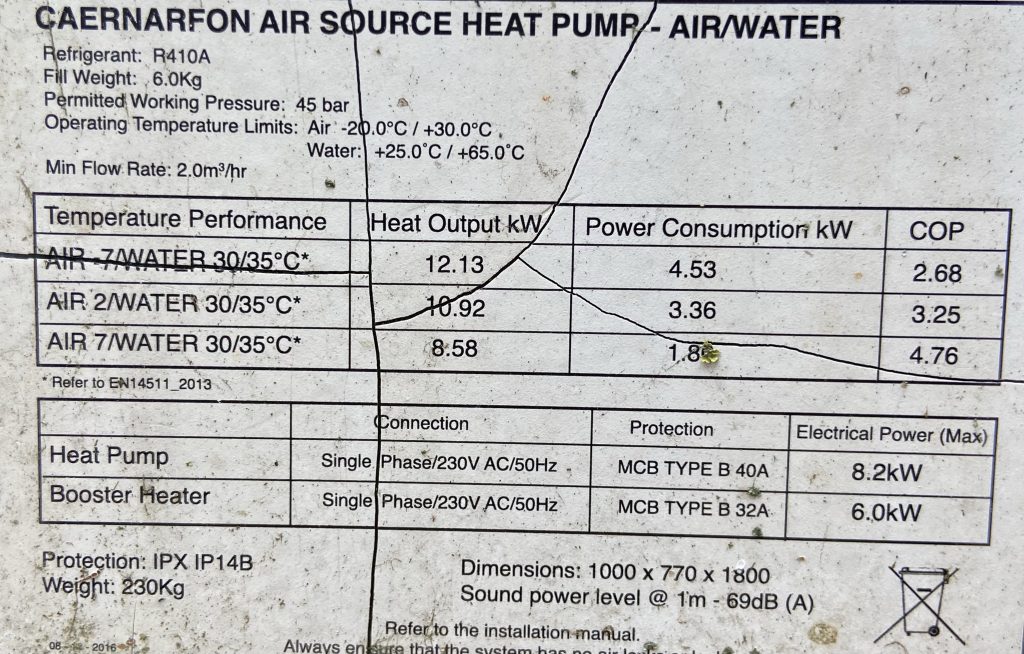We’ve had our heat pump from Global Energy Systems for over two years and we’re heading into our third winter. Over this period of time, we’ve made several tweaks to the system, the most significant being upsizing some radiators to Stelrad K3s in key rooms, but we’re still concerned about rising electricity tariffs and the financial implications this may have this winter. Given the unseasonably cool temperatures we’ve had in late August, our heating came on a few times, so I thought that this was an opportune time to play around with some settings to see if we could improve our efficiency.
We played around with the weather compensation settings on our heat pump (thank you Derek for going through the documentation), and it had very little impact on the efficiency of our system. The weather compensation setting is supposed to continuously calculate the required water temperatures dependant on environmental factors, such as outside air, and this is supposed to ensure that the heat pump is efficient all year round.
In our case, the issue with weather compensation is that the system is taking outdoor temperatures and optimising the system based on internal temperatures. Where this falls apart in our set up is that our control panel is installed inside the heating cupboard which is artificially warm all the time. This is something that would be great for homeowners that have had this installed in a hallway of central portion of the house. The long and short of it is that weather compensation did not work for us, so let’s move on.
Our heat pump’s lifetime coefficient of performance (based on approximately 30 months) is 2.7 based on a flow rate temperature of 45C. In late August, we dropped our flow rate to 35C to see what would happen. Would it continue to heat our home and would it have a marked improvement on our efficiency and COP? From August 21 to September 1, we ran our heat pump at 35C, and its use was triggered by our smart thermostats.
First the good news. Our COP over this 10 day period went up to 2.88 which is better than the 2.7 we’ve registered thus far. I appreciate that 10 days is also not a very a long time, so we’ll continue to run the heat pump at 35C for the foreseeable future (probably throughout the autumn) because rooms with underfloor heating and radiators have been able to come to temperature (typically round the 21C mark) and maintain it. We must also caveat this by saying that even though August has been cool, it’s not been cold, so we’ll monitor things by how warm the house is, and if rooms start to struggle, we’ll increase the flow rate to 40C and see where that takes us.
On a separate note, the heat pump’s published ratings differ vastly from what’s happening in reality. The table below is from our heat pump and shows how the heat pump should perform under certain conditions. Based on this, at air 7C and water 30/35C our COP should be around 4.7. At 2.88, we have some way to go, which is disappointing given that the ambient temperature, as an average, has been well above 7C – our average for this period has in fact been 16.5C.

From September 1-6, we have seen our COP get over the 3 mark for the first time. As the heat pump starts to run for longer periods, it seems that the efficiency is improving, which makes sense because it’s not having the stop/start spikes.
Since we are now in the midst of another heat wave, our heating is off and will probably will not be coming on for a while, so we will update this article in the weeks and months ahead to get more clarity and insights on the impact that a lower flow rate has on the our heat pump’s COP.



Keep up the good work.
So many people will need support through the transition.
Gotta laugh though (kindly) at the British Gas adverts!
Thanks Andrew. The ads are served by Google based on your interests, but I can see the irony 😂
Hi, the technical details of the heat pump are interesting. They reveal the reality behind air source heat pump specifications as marketed by manufacturers.
The COP below 8.58Kw is 4.76. That’s one thing. I can believe this.
However, the marginal COP between 8.58Kw and 12.13Kw can be calculated:
Marginal heat output = 12.13 – 8.58 = 3.55Kw
Marginal power consumption = 4.53 – 1.8 = 2.73Kw
Resulting marginal COP for heat output above 8.58Kw = 1.3.
Conclusion, this heat pump is just turning electricity into heat when working above 8.58Kw.
You thus need a bigger heat pump. I haven’t examined other ASHP specifications yet, but I am betting that all manufacturers are playing this game. Thus, the only way to buy an ASHP is to over-spec it, in order to avoid working in the marginal heat output region.
Your equation is not right.
You cannot subtract power used at +7 from the power used at -7 to give you the average at -7, from 8kw to 12kw.
The COP at -7 at power from 8kW to 12kW sits in between the COP at -7 at 8kW and the COP at -7 at 12kW power.
[…] Renewable Heating Hub. (2022). “Flow rates, efficiency and COP.” https://renewableheatinghub.co.uk/flow-rates-efficiency-and-cop […]